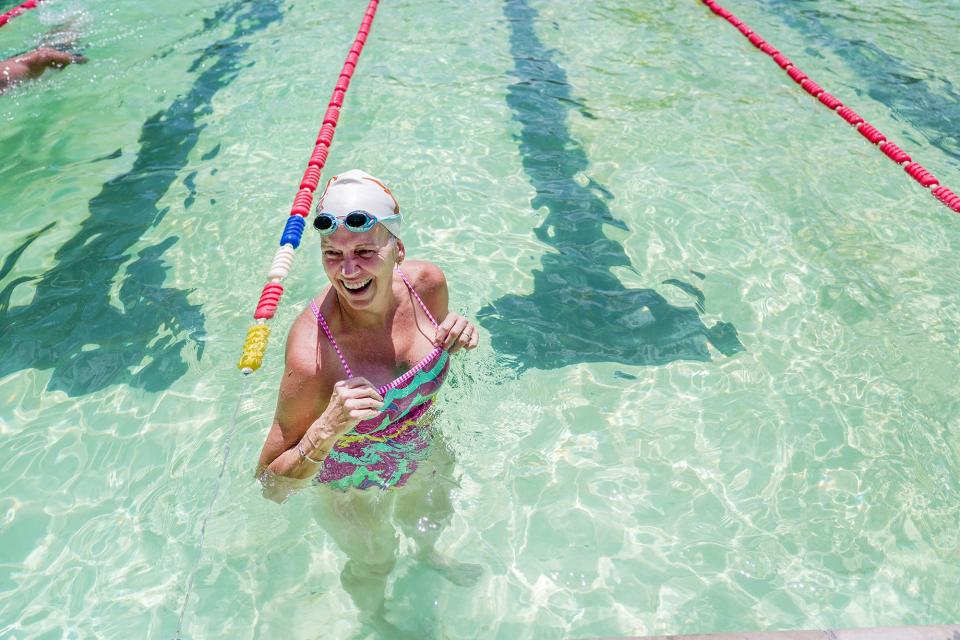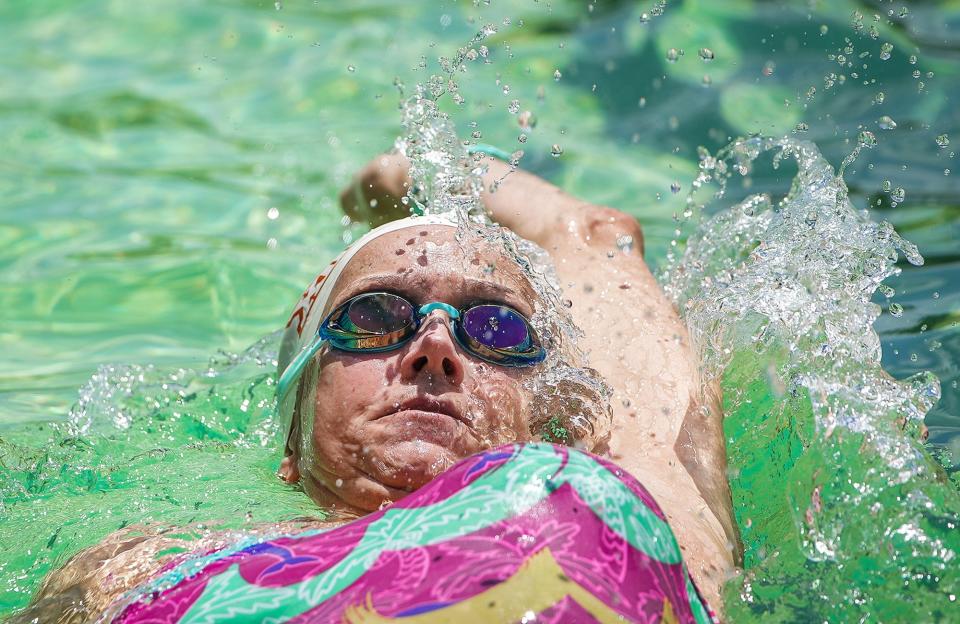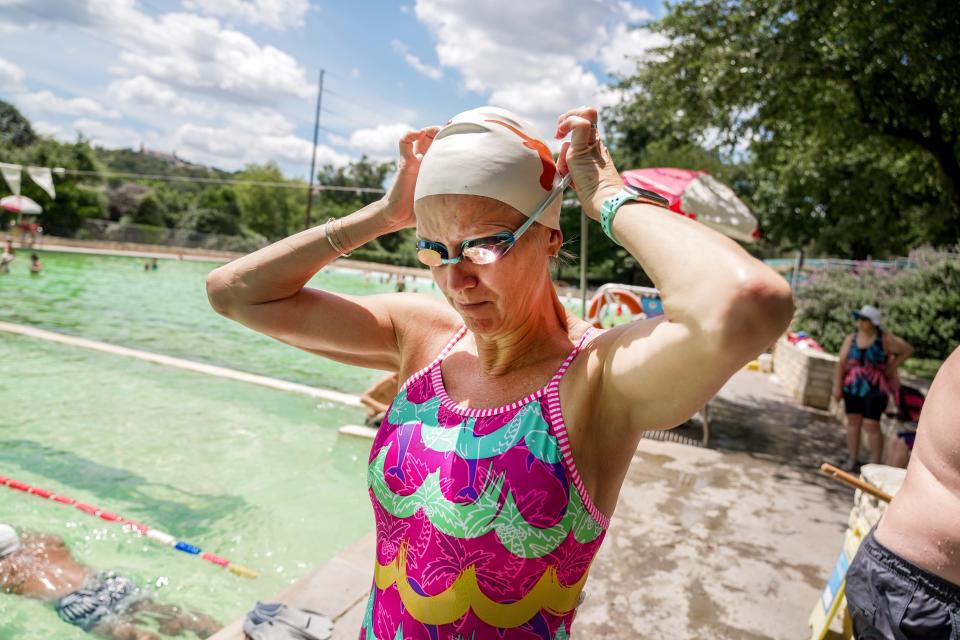Former University of Texas, Olympic swimmer Tori Smith returns to pool after back surgery
Tori Smith slices through the water at Deep Eddy Pool on a Friday afternoon. She swims some freestyle, a little breaststroke and the backstroke. The backstroke always has been her favorite, she said, because like a lot of people, she doesn't like to put her face in the water.
The backstroke is also what she competed in during the 1984 Olympics in Los Angeles, when she was known as Tori Trees, before she married husband John, a fellow swimmer at the University of Texas. She came in fifth in the 200-meter backstroke in the Olympics.
"It was always a dream of mine," she said. "I was just happy to be there. I wasn't supposed to be there. I qualified in eighth place."

At UT, Tori Smith swam the backstroke and the breaststroke, and she was a member of the team that won the NCAA national championship all four of her years from 1984-1987.
She did all of it without injury and the need for a surgery until last year, when the now 59-year-old needed a mobility-sparing surgery to fix her back. Her swimming career might have helped delay the surgery for decades.
Love of the pool is genetic
Swimming is a sport Smith has loved since her sister Tina taught her to swim when she was 8 and they were swimming in the quarry pool near Louisville.
After competing in the Olympics, she and her husband raised three kids and she became a swim coach.
This summer, Smith has been watching the Olympics in Paris, especially the swimming, where Regan Smith, Torri Huske, and, of course, Katie Ledecky, have impressed her. She also roots for Caeleb Dressel, who was her son's Clark's roommate at the 2016 Olympics in Rio, where Clark earned a gold medal in the 800 free relay. Clark also swam for the Longhorns. Her daughter Megan swam for the University of Akron, and daughter Samantha swam for Southern Methodist University.
This summer, Smith and the members of her 1984 Olympic team met up in Indianapolis for the U.S. swimming trials in Indianapolis.
"I have lifelong friends," she said of her time swimming.
Read more: 'A whole new life': How spine surgery ended years of pain for Central Texas teacher
Feeling a change in her body
Smith had made it through her competitive swimming days without injury, but in the fall of 2022, doing "anything hurt," she said. Washing dishes, walking up steps, doing anything aerobic. Even getting out of bed or moving in bed was a process.

Her husband noticed that Smith no longer could walk with a straight back. Smith was diagnosed with scoliosis, a curve in the spine that is often genetic. Her spine was pinching a nerve, and she had degenerative arthritis in her disks — all causing severe pain.
She tried many things, including physical therapy, massages and chiropractic care.
Finally, she decided to have surgery to fix her lower back. "I couldn't be in that much pain," Smith said.
While Smith's scoliosis was something to which she is genetically prone, the swimming actually might have kept it from progressing and delayed the need for surgery, said Dr. Craig Kuhns, an orthopedic surgeon at St. David's Medical Center and Austin Spine. "People with a strong core and taking care of herself and doing cardio keeps the scoliosis as good as it can get," he said. But with the wear and tear that comes with aging, her curve started getting worse, pushing out the disks on one side and causing the bones to slide sideways.
"That's when she got miserable," he said.
Read more: How an Austin woman left a wheelchair to run again after car accident

Sparing her mobility
Kuhns knew that Smith was highly active even 40 years after being in the Olympics. He could have done a more invasive surgery that would have involved more of her back and her pelvis, but he wanted her to be able to continue to swim with mobility.
So he went into her back through the side, which spared more of her muscles. He put in two rods to straighten the spine, removed four discs and put in spacers to protect the spine from compressing. He used GPS-guided screws to hold the hardware. Doing surgery this way, he avoided fusing her spine to her pelvis, which would have limited her mobility.
The surgery on April 25, 2023, Smith said, "was instant relief." She was able to walk that night, and for her recovery, Kuhns prescribe walking and not pushing herself too much for the first six months. At the six-month mark, she could return to the pool.
"Swimming is really good for the spine," Kuhns said. "It's low-impact cardio and stretching and strengthening the spine. You can't get better than that."
Smith was most concerned about doing flip turns in the pool with her rebuilt back, but the concern was more mental than physical, she said, and she built her way back to her regular swimming routine, which is about a mile and a half of laps twice a week.
Kuhns expects Smith's back surgery will last for the rest of her life if she takes care of it by staying active and protecting it with core strength. If she experiences numbness, pain or tingling in her legs, arms or back, it might be a sign that a more flexibility-limiting surgery will be needed.
"It feels great today," she said of her back. "I don't feel any pain."
This article originally appeared on Austin American-Statesman: Former UT, Olympic swimmer returns to pool after back surgery

